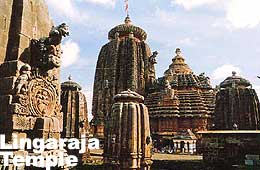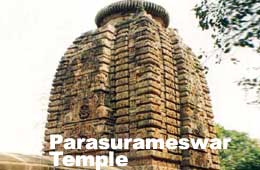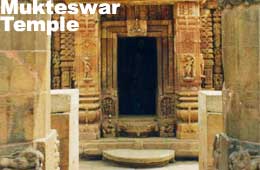| India Profile » Monuments and Temples in India » Temples of Bhubaneswar | |
Temples of Bhubaneswar | |
 | |
 Bhubaneswar is also called the 'City of Temples'. It boasted of more than 7000 temples located around Bindusagar tank in the old city. Only 500 of those temples survive today some of which are really magnificent. Orissa formed a part of the Kalinga Kingdom. In 260 BC, Emperor Ashoka defeated the King of Kalinga. But soon the bloody battle filled Ashoka with remorse and he renounced war and violence forever. He embraced Buddhism and followed the path of peace, pity, compassion and non-violence. Soon after Ashoks's death Buddhism in Orissa declined and Jainism had the sway under the mighty arm of Kharvela until Buddhism again became a popular faith in 2nd century B. C. Under Kharvela Orissa attained new heights in art, culture trade and commerce. The coming of the Kesari and Ganga Kings marks the culmination of Orissa art and culture. These kings were very powerful and ambitious builders. They were followers of Shaiva and Vaishnava faith. The temples of Bhubaneswar, Puri and Konark were constructed during their reign (712-1200 AD). In 1568 AD, the last Hindus ruler of Orissa was over-thrown by a Muslim general and finally Orissa was annexed by Akbar in 1592 AD. The bigoted Muslim invaders destroyed hundreds of Hindu and Jain temples. In 1803 AD Orissa came into the British possession. Orissa became a separate province in 1936 with Cuttack as its capital. The location for the capital was selected because of its central location, high altitude, good communication, vast plateau like high uplands sloping to the sides, eco-friendly climate and above all deep-rooted historical significance with left out landmarks of architectures and sculptures. The capital was shifted from Cuttack to Bhubaneswar in 1948. Pt. Jawaharlal Nehru laid the foundation stone of the new city in when Dr. Harekrushna Mahtab was the Chief Minister of Orissa. Lingaraja Temple
Lingaraja temple is the epitome of the Orissan temple architecture. It is one of the most beautiful temples in India. The main deity of the temple is Hari-Hara that is half Shiva and half Vishnu. The deity is also referred to as "Tirubhuvaneshwar" meaning "Lord of the Three worlds". Parts of this temple are over 1400 years old. But the present structure dates back from 1090 to 1104 A.D. the measurement of the temple is 520 ft by 465 ft. the original structure consisted only of mandap and garbhagriha. Nat Mandir and Bhog Mandir were added later. There are several votive shrines around the temple. The exterior of the temple is lavishly decorated with beautiful sculptures of birds, animals, floral motifs, human figures in erotic postures and gods and goddesses. The sanctum contains the lingam made of uncarved granite, which is plain without any embellishment. The lingam is 8 ft in diameter and is raised 8 inches above the ground. The deity is given a bath daily with water, milk and bhang. Rajarani TempleThe Rajarani Temple was built in the 11th century AD. It is proportionate in measurement. It stands majestically in a green field. it was constructed around the 11th century and dedicated to Lord Brahma. It has no presiding deity now and is longer used for worship. There is a beautiful 59 feet high tower in the temple. The temple is also noted for its excellent sculptural art of erotic postures of mithuna couple, nayikas, nymphs, gajasimha and other intricate stone carvings. The jagmohan of the temple is plain yet majestic while the sanctum is profusely decorated. The temple got its name because of the red-gold color of the local stone, Rajraniya, of which it is made of. Vaital Deul TempleVaital Deul temple is situated near the Bindu Sarovar tank. It was build during 8th century AD. It is devoted to the Goddess Parvati-Chamunda or the Shakti. The goddess seated on a corpse, is placed in the main sanctum of the deity. The deity is adorned with garland of skulls around her neck, holding weapons in her arms and flanked by a jackal and an owl. The goddess is portrayed as the slayer of Mahisasura, the buffalo demon. The niches on the inner wall depict scenes of tantric rituals. It was the first temple to depict erotic sculptures on the walls of the temple. The unique feature of the temple is that the interiors are embellished but the outer walls are plain. Mukteswar templeThe Mukteswar temple was built around the 10th century AD it belongs to later phase of Kalinga school of temple architecture. The temple is exquisitely decorated. It depicts tales from Panchatantra.the niches of outer wall of the compound show the images of Buddhist, Jaina and Hindu pantheon. The temple is dedicated to Shiva in the form of Mukteshwar, which means "The Lord who bestows freedom through yoga". The tower of the temple measures 10.5 m. The high point of the temple is the torana. The decorative gateway with two female figures is worth seeing. There are figure of ascetics in various poses of meditation depicted on the walls of the temple.  Parasurameswar TempleParasurameswar temple is one of the oldest Siva temples (late 7th century) in the State. It is made on the Kalinga School of temple architecture. It was built in 650 AD. It is dedicated to Lord Shiva. But the images of Vishnu, Yama, Surya and Mother Goddess are also found here. The temple is exquisitely carved. The friezes of the temple depict the intricate carvings of elephant and horse processions, human figure, floral motifs and the bust of Shiva. The Shahastra lingam or the 1000 small lingams joined together at the corner of the courtyard can be seen. Brahmeswar TempleBrahmeswar temple belongs to the mature Orissan School of Temple Architecture. The deul and the jagmohan of the temple are beautifully carved. The temple depicts musicians and dancers on the outer wall of the temple for the first time. The iron beams are also used for the first time. Chamunda, Shiva and other deities are depicted in the western end of the temple. The temple has a living deity, which is shown through the saffron pennant flying from the top of the temple. There are several other temples to be visited in Orissa. They are Luxmaneswar, Satrughaneswar and Bharateswar temple, 16th century, Swarna Jaleswar temple, 7th century, Brahmeswar temple, 11th century AD, Bhaskereswar temple and Bharateswar temple etc. |
|
 |
